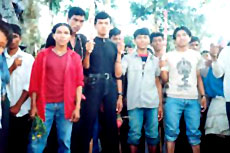 Majhi tribes have got rich heritage with their unique culture, clothing and language inhabiting in Madhya Pradesh. This tribal people are said to be the indigenous group of Nepal. The rivers of Nepal have a great impact in the lives of this tribal group.
Majhi tribes have got rich heritage with their unique culture, clothing and language inhabiting in Madhya Pradesh. This tribal people are said to be the indigenous group of Nepal. The rivers of Nepal have a great impact in the lives of this tribal group.
Majority of these Majhi have adapted to several occupations. The chief conventional occupation of the Majhi tribes is boat making. The people of this group are engaged in the transporting people from one bank to another. Even these Majhi tribes take up to fishing as occupation to meet the needs of the day to day living.
The Majhis also tried their hands in trading and business. Especially the Majhi females sell several goods like Merch and Jand including mats made of patter in the local markets. The products of the Majhi tribes are so exquisite that they have got high demands in the markets of the region as well as that of the whole of the country.
After conducting several surveys on the lives of these Majhi tribal communities, the anthropologists have rightly inferred that much of the tradition and ancient customs have been obliterated and at the same time incorporated new trends and practices. So much so, that now a days these Majhi tribes also have taken up professions as cultivator, laborer etc.
These Majhi tribes have got identifiable features, which enable any one to easily distinguish a tribal member of this Majhi community. These Majhi tribes have got very dark brown in skin complexion, average height and strongly built body. In other words, these Majhi tribes have got the typical Mongoloid features.
Maximum members of this Majhi tribal community live in ancestral places in simple circular houses which are made either of stone or clay. Their houses are round shaped and these houses have got a single door; they are always built very close to each other. While making a new house a Majhi will ascertain whether the house spot is appropriate or not by combining the soil of the four corners of the selected site with `mercha` (a type of medicine used to prepare `JAND`). If the soil is tasty, it is supposed that the selected house spot is the appropriate one, if it is not, then these Majhi tribes immediately reject it as an inapt location.
Just like many of the tribal communities of the Indian subcontinent, these Majhi tribes too are bit oriented to religion and spiritualism. Majority of these Majhi tribes practice the Tantrik religion. In fact the Majhi tribes have not constructed any of the temples or man made shrines for worship. Instead these Majhi tribes have established all their local goddesses and gods at the bottom of a tree near a river. These Majhi tribes follow animism as their conventional religious practice and custom.
They follow animist religion. Moreover, the Majhi tribal community has got a plethora of deities of the local origin. The principal God of the Majhi people is Gharbhimsen. They also worship a number of gods and goddesses like Gaidu, Jaurekhee, Ardev, Jangali, Setidevi, Goresiddhi, Shikari and lord Shiva. As an integral part of the worship of these local deities, totala flowers are widely used. Festivals are part and parcel of the society of the Majhi tribes.
The major festival of these Majhi tribes is koshi pooja. Moreover, there are some other festivals like saune sangranti and marigshire purnima. Dresses of this Majhi tribal community are quite exquisite. The customary Majhi clothing constitutes of kachchhad, short gunyu, istkot, bhoto and pheta, black `kilt`, white patuka and majetro. Majhi females are also fond of jewelleries. These include thokka of silver on the wrist, haar of compani rupee, hasuli of silver and short black pote around the neck.
The Majhi tribes converse with each other in the language of the same name. It belongs to the `Indo-European`family. Mostly the Majhi tribes residing in the districts of Kavrepalanchowk, Dolakha, Ramechhap, Khotang and Okaldhunga converse in this language. That this Majhi tribal community has abstained from education and learning is quite apt from the literacy rate. For example, Majhi can only count up minor literacy rate. Only a handful of the Majhi tribal community are there who have been employed in offices like police, army etc.
















